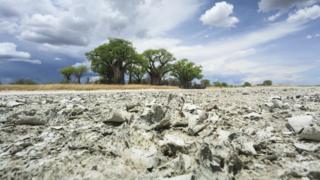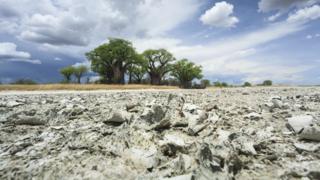Origin of modern humans ‘traced to Botswana’
Scientists say the possible homeland of all humans alive today is an area south of the Zambesi River. …

 Image copyright Getty Images
Image copyright Getty Images Scientists have pinpointed the homeland of all humans alive today to a region south of the Zambesi River.
The area is now dominated by salt pans, but was once home to an enormous lake, which may have been our ancestral heartland 200,000 years ago.
Our ancestors settled for 70,000 years, until the local climate changed, researchers have proposed.
They began to move on as fertile green corridors opened up, paving the way for future migrations out of Africa.
“It has been clear for some time that anatomically modern humans appeared in Africa roughly 200,000 years ago,” said Prof Vanessa Hayes, a geneticist at the Garvan Institute of Medical Research in Australia.
“What has been long debated is the exact location of this emergence and subsequent dispersal of our earliest ancestors.”
Prof Hayes’ conclusions have drawn scepticism from other researchers in the field, however.
Lakeland haven
The area in question is south of the Zambesi basin, in northern Botswana.
The researchers think our ancestors settled near Africa’s huge lake system, known as Lake Makgadikgadi, which is now an area of sprawling salt flats.
“It’s an extremely large area, it would have been very wet, it would have been very lush,” said Prof Hayes. “And it would have actually provided a suitable habitat for modern humans and wildlife to have lived.”
After staying there for 70,000 years, people began to move on. Shifts in rainfall across the region led to three waves of migration 130,000 and 110,000 years ago, driven by corridors of green fertile land opening up.
The first migrants ventured north-east, followed by a second wave of migrants who travelled south-west and a third population remained in the homeland until today.
This scenario is based on tracing back the human family tree using hundreds of samples of mitochondrial DNA (the scrap of DNA that passes down the maternal line from mother to child) from living Africans.
By combining genetics with geology and climate computer model simulations, researchers were able to paint a picture of what the African continent might have been like 200,000 years ago.
Reconstructing the human story
However, the study, published in the journal Nature, was greeted with caution by one expert, who says you can’t reconstruct the story of human origins from mitochondrial DNA alone.
Other analyses have produced different answers with fossil discoveries hinting at an eastern African origin.
Prof Chris Stringer of the Natural History Museum, London, who is not connected with the study, said the evolution of Homo sapiens was a complex process.
“You can’t use modern mitochondrial distributions on their own to reconstruct a single location for modern human origins,” he told BBC News.
“I think it’s over-reaching the data because you’re only looking at one tiny part of the genome so it cannot give you the whole story of our origins.”
Thus, there could have been many homelands, rather than one, which have yet to be pinned down.
Evolutionary milestones in human history
- 400,000 years ago: Neanderthals – our evolutionary cousins – begin to appear and move across Europe and Asia
- 300,000 to 200,000 years ago:Homo sapiens – modern humans – appear in Africa
- 50,000 to 40,000 years ago: Modern humans reach Europe.
Follow Helen on Twitter.


